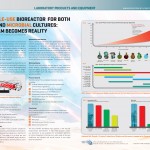 Application of single-use equipment is common practice in the biopharmaceutical industrial and academic field. Compared to the traditional glass or stainless steel bioreactors, single-use bioreactors offer clear advantages: a quicker turnaround time; minimal utilities required; greatly reduced risk of cross contamination; more operational flexibility; reduced validation requirements. However, until recently, single-use bioreactors have a restricted application, only to animal cell cultures due to limitations in mixing and mass-transfer.
Application of single-use equipment is common practice in the biopharmaceutical industrial and academic field. Compared to the traditional glass or stainless steel bioreactors, single-use bioreactors offer clear advantages: a quicker turnaround time; minimal utilities required; greatly reduced risk of cross contamination; more operational flexibility; reduced validation requirements. However, until recently, single-use bioreactors have a restricted application, only to animal cell cultures due to limitations in mixing and mass-transfer.
As single-use technology not only has significant benefits for cell culture processes, but clearly also in microbial fermentation processes as in seed-trains, process development and small scale production, there is a strong need for single-use bioreactors supporting more demanding fermentation processes.
Therefore we developed the CELL-tainer® single-use bioreactor with a working volume up to 25L, able to create a superior mixing and oxygen mass-transfer compared to first generations single-use bioreactors. In the CELL-tainer® a kla up to 300 hr-1 is easily achieved, making the system suitable for both high density cell cultures and microbial cultures, and even for viscous mycelia cultures.
The CELL-tainer® results in terms of viable cell density and protein production of cell-lines like CHO-cells, PER.C6®-cells, insect-cells, are comparable to conventional stirred bioreactors. Also microbial organisms like E.coli, Corynebacterium, Pichia show comparable results. This with all the advantages of single-use technology. As kla values and other vital process parameters can be controlled, the CELL-tainer® is the ideal multi-purpose equipment for process development, pre-culture and small-scale production.
The CELL-tainer® bioreactor has opened a new area for bioprocesses optimization. As for a complete spectrum of culture organisms, a wide range of process conditions and volumes can be achieved and controlled in one single piece of equipment, a real multi-purpose single-use bioreactor is now available.
